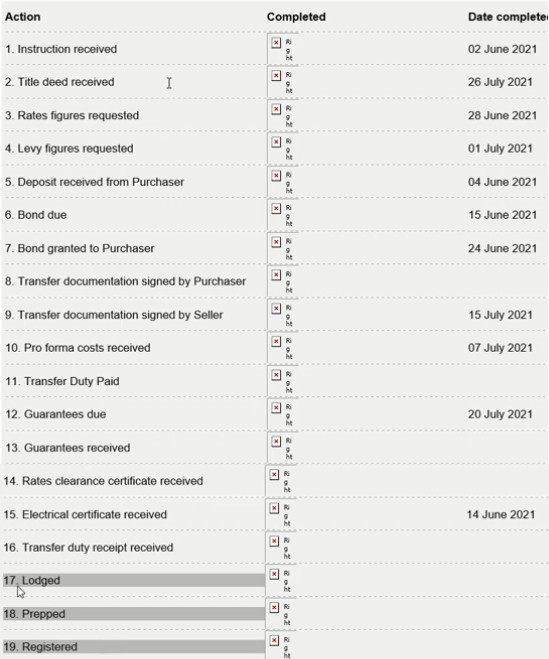When it’s your first time buying a property, you might not be aware of all the legal steps you go through when transferring ownership from one owner to the next.
What is the property transfer process? How long does it take? What steps are included? These are common questions I get from first time property buyers, so I’ll take you through the normal sequence of events that you go through when you’re doing a property transfer.
I’ll show the process from my perspective as the seller because at the time of writing this, I was in the process of selling one of my properties. So, I’ll just share with you exactly what the transfer attorneys have given me in terms of the structure that they follow.
How long does the process take?
It normally takes about three to four months to transfer a property from the seller into the buyer’s name. The reason for that length is because there’s a lot of documents that need to be signed by both the seller and the buyer. There’s also a lot more checks and balances that need to occur now because of Covid. So, you might want to budget five to six months instead of four, depending on the backlog that your municipality is dealing with.
Property transfer steps
A lot of transfer attorneys I’ve worked with use this Lexis Tracker automation tool. What they’ll do is send me a weekly update showing me what they’ve done so far.

Before we continue, have a look at the “Date completed” column. You’ll notice that the timelines don’t necessarily correlate with the actions and that’s pretty common.
The process doesn’t always happen in exact order. You might do step one, then six, then three, then four in terms of the dates that they are completed, which makes it a bit confusing. For the purpose of this article, I’m going to go line item by line item, but don’t be confused if the date doesn’t correlate with the action number.
- Instruction received
On the 2nd of June, I got a signed offer to purchase (OTP) from an interested buyer. I then asked my attorneys to start the property transfer process. That’s what instruction received means. It’s when you’ve got a signed OTP between a buyer and seller and the attorneys are now involved.
- Title deed
Once the instruction has been received by the attorneys, me as owner and person who is selling the property, I have to provide the attorneys with the title deed.
A title deed is a piece of paper that says I’m the legal and rightful owner of this property. I hand it over to the attorneys because they’re obviously going to transfer that to the new owner. However, new owner (i.e. the buyer) will not receive the title deed until transfer has been completed and full payment for the property has been received by the buyer (which is me in this case).
That’s where the order of these actions comes into play and that’s why you’ll see the dates don’t necessarily correlate.
- Rates figures requested
This is where the attorneys will contact me and ask for a utility bill because over the next three to four months, while the transferring is happening, I need to be able to ‘clear’ that amount.
What does that mean?
Let’s say the seller’s rates and taxes bill is R1000 per month. Since the property is still in their name while transfer is happening over three to four months, they have to prepay their utility bills so that by the time it gets into the new owner’s hands, they have no debt. They have no additional costs. They can start on a clean slate.
In this case, my rates and taxes would be R4000. I’ll have to prepay that to clear the rates and taxes bill for the next four months so that when the ownership registers into the new person’s name, they start on a clean slate.
- Levy figures requested
The same thing with rates happens with levies, so make sure that your body corporate or your levy account is up to date.
- Deposit received from purchaser
If, for example, the buyer, gets a 90 percent loan from the bank, then 10 percent needs to be put down by the buyer. That’s part of the terms and conditions of the OTP.
- Bond due date
This is the amount of time the purchaser has to get a bond. You can see that I gave them two weeks, essentially from when the instruction was received up until the point where the bond was due.
- Bond granted to the purchaser
This is the date when the bank came back to the purchaser and agreed to give them the home loan. In the case of my property’s buyer, the bank got back to him about a week later. So, I gave a bit of leniency.
The bond due date is when the bond grant must be given and bond grant is when the grant was actually given.
- Transfer documentation signed by purchaser
The purchaser and the seller must both sign the transfer documents in front of a commission of oath. You cannot sign transfer documents electronically. You have to go into the attorney’s office and they’re going to have a commission of oath.
The reason my property’s transfer documents took so long to get signed is because the new buyer is overseas. He’s somewhere in Saudi, so I went ahead and signed on the 15th of July. It then needed to be couriered to Saudi, where the buyer could sign under a commission of oath.
- Transfer documentation signed by seller
See point 9 above
- Pro forma costs received
These are the cost that the transferring attorneys are going to have. They include things like their FICA, petties and their costs for doing the work. They’ll send you a statement and you’ll need to pay.
- Transfer duty Paid
These are the tax costs (to SARS) that need to be paid as part of the transfer. The buyer is the one who will have to pay the transfer duties and they form part of the buying costs. The seller pays the estate agent’s commission.
- Guarantees due
The bond registration and transfer duties are payable by the buyer. Guarantees due.
- Guarantees received.
This is when the bank needs to pay by, or when your deposit needs to be paid by or at least your bond approval needs to be in place. That’s when it’s paid into the attorney’s trust account.
- Rates clearance certificate received.
Remember, in step three, the seller has to prepay the utility bill for X number of months. The attorney will work out that calculation for the seller and they’ll send them the amount they have to pay. Step 14 continues from step three and this is when the attorney goes to the seller’s municipality and requests an updated statement of their rates account. It needs to show zero or it needs to be paid up. That’s what is meant by rates clearance certificate. It’s when the attorney’s have proof that the seller’s rates account has no more debt because the buyer must come into the property, not with any debt from a rates and taxes perspective or levies unless it’s stated in the OTP. Most of the time the buyer taking over should have a clean slate.
- Electrical certificate
The electrical certificate is very important and the seller has to pay for this. The seller needs to get an electrician to come and view the property to run some tests. He’ll check the lights, switches, plugs, etc. to make sure the electrical system is in order and then give you a certificate confirming it’s safe and working.
In my case, I think I had to pay about R 2000 to get the certificate.
- Transfer duty receipt paid
That’s when you get confirmation from SARS that transfer duty (from step eleven) has been paid.
Steps 17-19: Lodged, prepped and registered
This is when the buyer is getting really close to actually transferring the property into their name. Once it’s lodged, transfer is imminent. It’s about another two weeks of waiting while the attorneys lodge transfer of ownership at the deed’s office. They’ve got some prepping to do from a legal documents’ perspective. And then finally, step 19 is when it’s registered. That’s means the buyer is officially an owner of the property.
This may be a little bit intimidating and overwhelming, but remember that your attorney is going to be walking you through it step by step. They’ll provide you with all the things you need to do. Hopefully they use a tool like my attorney’s Lexis Tracker, which gives you an update on a weekly basis on shows you what step is next.
As long as you’re staying on top of things and you’re nagging your attorney every now and again when you need stuff done, the transfer process is actually quite seamless.


